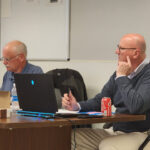“Here is your country,” President Theodore Roosevelt once told us. “Cherish these natural wonders. Cherish the natural resources. Cherish the history and romance as a sacred heritage — for your children and your children’s children.”
Roosevelt, the father of American conservation, knew the beauty of Maine well. Indeed, as a young man he climbed Katahdin and spoke admirably of the very land that last year was designated as the Katahdin Woods and Waters National Monument. Now, Interior Secretary Ryan Zinke, another champion of American conservation, has had the same opportunity to appreciate Maine’s beauty by exploring the monument — and it is my hope that he, like Roosevelt, will come to cherish this land as a part of our sacred heritage.
Indeed, the heritage of the Katahdin region is rich and storied, defined by the grit and resilience of a hardworking and rugged people who took to the outdoors not just for pleasure, but for a living as well. For generations of families, Maine’s paper mills provided steady jobs with good salaries and even better benefits. In fact, to this day, East Millinocket still knows itself as “The Town that Paper Made” — an apt moniker that pays tribute to the history of the region. And while the moniker rings true, what is now different is that those paper mills, along with their plentiful jobs, have gone away.
We can debate the reasons why, but what we know for sure is that, as a result of rapid changes in forest products manufacturing, the past decade has been a difficult one as residents have watched jobs come and go and businesses close their doors for the last time. For many, it was as if a slow moving economic hurricane swept through their communities, leaving — perhaps worst of all — a feeling of hopelessness and despair in its wake.
Indeed, it was that sense of loss and the real, significant economic hardship that people across the region felt that drove U.S. Sen. Susan Collins and me, along with U.S. Rep. Bruce Poliquin, to harness the power of the federal government in the form of a multi-agency Economic Development Assessment Team to visit the area and work side-by-side with local governments, businesses, entrepreneurs and innovators to access new markets for forest products and chart a course to greater economic prosperity. That work to build upon our vast timber resources and strengthen the future of our forest economy continues, and it is a critical pillar to the long-term revitalization of the region.
Another undeniable pillar, however, is the Katahdin Woods and Waters National Monument. Since the monument’s designation last year, I have heard from businesses throughout the area — from hardware store owners, grocers, and lumber retailers to recreational equipment suppliers, lodge and inn operators, and realtors — who have all testified that the monument has been a much-needed boost to their businesses and the regional economy as a whole. In fact, these positive developments have led many local elected officials who once opposed the monument to reverse their positions and work unabashedly to secure its success.
I know that this administration is serious about growing jobs in rural America, and if there is a lesson to be learned from past generations in and around Katahdin, it is that we cannot allow ourselves to become reliant upon a single industry. The key to success will center on economic diversification, and, with the implementation of the Economic Development Assessment Team’s roadmap and support for the forest products sector, I am confident that Maine’s forest economy can and will flourish beside Maine’s monument — if we allow it.
So, as Secretary Zinke visits the Katahdin and Woods and Waters National Monument, and as he comes to learn about the extensive public input process that occurred years in advance of its designation, I hope he takes a moment to enjoy its splendor. And I hope he comes to understand how proud we are of our heritage and how much we look forward to our future. The monument is a vital part of that future, and I firmly believe that the sooner we are able to reaffirm its designation, then the sooner we are able to continue on with healing and rebuilding a region that has experienced too much hardship, too much heartache, and too much division.
The future is bright, indeed — please allow us to seize upon it.







